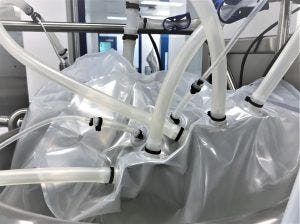July 10, 2019

Biopharma is starting to use single-use technologies more widely but understanding the pros and cons is vital say experts.
The key characteristic of any single-use technology is its disposability. Being able to throw away rather than clean equipment after use is a major benefit.
Cleaning a stainless steel system takes time and money says Andrew Sinclair, founder of Biopharm Services.

“Cleaning a typical stainless steel system can be complex as the equipment and associated pipework needs to be cleaned together and in some cases sterilized with steam before use.
“These activities are equipment dependent and can take several hours in the case of a bioreactor and say half an hour for a buffer vessel clean,” he said, adding that cleaning is usually done using one or more clean in place skids which are complex and costly.
Regulators
Cleaning also comes with regulatory challenges. For one thing manufacturers must re-validate cleaning systems each year.
Single-use techs let companies bypass cleaning steps according to Sinclair. “As they are supplied pre-irradiated they eliminate the need for Steam in Place and Clean in Place.
“Where they comprise the whole operation they significantly reduce capital and water usage. In addition, they can reduce the amount of labor and the facility size for a given capacity when compared to traditional stainless-steel facilities.”
A clean break
Eliminating cleaning cuts downtime. But single-use technologies can improve “productivity” in other ways Sinclair says.
“It depends how you define productivity. If you define it as kg/yr the difference will be an increase of a few percent compared to Stainless Steel.
“If you measure as kg of output per operator per year it may lie between 10% to 20% improvement. If you measure it terms of water kg of water used per kg of product then the amount of water required could fall by up to 80%,” he said.
Disposal
So disposability is the key advantage of a single-use technology. It is also the main challenge involved in using them.
Pall’s Helene Pora told us, “Usually, the main steps consist in decontamination using an autoclave when it has been in contact with biological products and then disposal. This has to be done according to local regulations. Very often, the products are being handled then through a waste management company.”
There are also logistical challenges. Pora said, “There is a need to ensure that the systems are functionally closed to eliminate any opportunity for dripping or leaking.
“Users must also be careful about the handling; the single-use system can be quite heavy once a number of them have been connected together for the bioprocessing steps.”
Plastic not fantastic
Also, single-use systems (SUS) are hard to recycle. Most include several types of plastic components, each of which have need disposal processes.
Sinclair told us, “There is no easy route for recycling the plastics. The complex mixes of different plastics [single-use techs contain] make them difficult to process in conventional recycling streams,” adding “this means the main routes for disposal are landfill or incineration.”
This view is echoed by Pora, who told us “as a lot of the SUS are made from a wide variety of components, with a wide range of materials of construction, recycling typically involve burning the plastic into oil.”
Pora said, “Usually, the SUS are burnt and you are generating energy,” adding that “roughly one kg of SUS is equivalent to the same amount of oil.”
About the Author
You May Also Like




